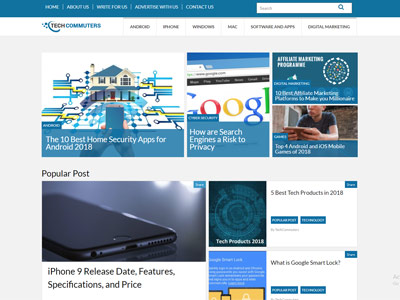Explore Thought-Provoking Articles on the Best tech blog for Tech Lovers
Explore Thought-Provoking Articles on the Best tech blog for Tech Lovers
Blog Article
Recognizing the Increase of Edge Computing in Today's Digital Globe
In the quickly advancing landscape of modern technology, edge computing becomes an essential pressure, reshaping how information is refined and utilized. This paradigm change is driven by the spreading of IoT gadgets and an intensifying demand for instant data processing. By transitioning data administration closer to the resource, side computer addresses crucial latency concerns while maximizing data transfer usage and boosting security steps. As sectors pivot towards smarter, extra effective systems, understanding the subtleties and implications of this technological development ends up being imperative. What does this mean for future advancements and the digital environment all at once?
What Is Side Computing
Side computing, although a relatively current advancement in the realm of innovation, fundamentally transforms how information is refined and managed by bringing computation and information storage space closer to the area where it is needed. Unlike standard cloud computing versions, which typically count on central information centers that can be geographically distant, edge computer decentralizes information handling. This closeness lowers latency, boosts real-time data processing, and improves the general individual experience by guaranteeing much faster reaction times.
At its core, edge computer includes a network of local tools and infrastructure, such as entrances, sensing units, and routers, with the ability of processing data at or near the source. This local processing capacity is especially essential for applications needing immediate information evaluation, such as autonomous cars, industrial automation, and clever cities. Additionally, by unloading information handling jobs from main web servers, edge computer reduces bandwidth demands and enhances data personal privacy and safety and security, as delicate details can continue to be on-site rather than going across extensive networks.

Key Chauffeurs of Fostering
Several factors are thrusting the adoption of edge computer in today's electronic landscape. One of the key vehicle drivers is the rapid boost in connected tools, typically referred to as the Internet of Things (IoT) This surge develops substantial amounts of data that need to be refined quickly and effectively. Side calculating addresses this demand by making it possible for data processing closer to the data resource, lowering latency and boosting real-time decision-making capabilities.
An additional significant driver is the demand for boosted data transfer performance. Central cloud systems can become overwhelmed with the sheer quantity of data created by IoT devices, leading to traffic jams (Best tech blog). By processing data at the side, companies can minimize network blockage and boost total system efficiency
Moreover, safety and privacy problems are pushing organizations towards side computing. By refining sensitive data locally, firms can alleviate dangers related to data transmission and exposure to prospective cyber hazards.
The increase of applications calling for real-time processing, such as independent vehicles Web Site and increased reality, also requires the fast action times that edge calculating provides. Collectively, these vehicle drivers are making edge calculating a crucial part of modern IT facilities, leading the means for its prevalent fostering across various industries.
Benefits Over Cloud Computer
Just how does side computing distinguish itself from standard cloud computing? Mostly, side computing brings data processing closer to the source of data generation, often on nearby web servers or regional devices, rather than relying on central information.
Additionally, side computer boosts data transfer performance (Best tech blog). By refining information locally, only the essential information is sent to the cloud for further analysis or storage, lowering the quantity of information that traverses the network. This not only alleviates network congestion but additionally lowers data transmission expenses
Edge computer additionally supplies better data privacy and safety and security. Delicate information can be refined in your area without being sent out to the cloud, minimizing the direct exposure to possible cyber threats. This is specifically useful for markets managing confidential info, such as health care and economic services.
Moreover, side computing makes sure higher visit this page durability and dependability. Regional handling enables continued procedure even when connection to the cloud is compromised, maintaining vital features and services despite prospective network interruptions. These advantages collectively show edge computing's transformative potential in optimizing efficiency and safety and security in electronic ecological communities.
Considerations and difficulties
While edge computing supplies numerous benefits, it likewise offers unique obstacles and considerations that should be addressed to completely understand its possibility. In addition, managing and checking a decentralized network of edge tools can be complicated, needing innovative devices and strategies to make certain smooth procedure and upkeep. Best tech blog.
One more factor to consider is the scalability of edge computer solutions. As the variety of connected tools grows, so does the demand for processing power at the side, which can cause source restraints. Organizations has to meticulously prepare their facilities to fit this growth without compromising efficiency or efficiency.
Interoperability is another important aspect. With various equipment and software application components entailed, making certain compatibility and seamless integration can be difficult. Standardization initiatives are necessary to facilitate communication in between disparate systems.
Future Trends in Edge Computer
Anticipating the future, edge computing is positioned to revolutionize different industries by allowing faster data processing and lowering latency. As the volume of data produced by IoT devices continues to expand, side computer will come to be progressively vital in managing this influx efficiently.
Another emerging trend is the growth of edge-native applications developed specifically to utilize the distinct abilities of edge computer. These applications will maximize efficiency and source use, resulting in enhanced efficiency across numerous sectors. Advancements in 5G technology will better reinforce edge computer by giving the essential facilities for high-speed, low-latency interaction between devices and side nodes.
Verdict
Side computing's increase is driven by the spreading of IoT gadgets and the demand for real-time information processing, which enhances efficiency by minimizing latency and decentralizing information administration. This method minimizes data transfer inefficiencies and safety and security issues, helping with advancements in applications like wise cities and self-governing automobiles. Regardless of challenges such as framework intricacy and integration, the future of edge computer assures a more responsive digital ecological community, with proceeded advancements forming its development and increasing its applicability across industries.
Edge computer, although a fairly recent advancement in the world of innovation, basically transforms just how information is processed and taken care of by bringing computation and data storage closer to the location where it you could look here is needed. Unlike conventional cloud computer models, which often count on centralized data centers that can be geographically distant, side computer decentralizes information handling. Additionally, by offloading information processing tasks from main servers, side computing lowers data transfer needs and improves information personal privacy and safety and security, as sensitive information can continue to be on-site rather than going across substantial networks.

Report this page